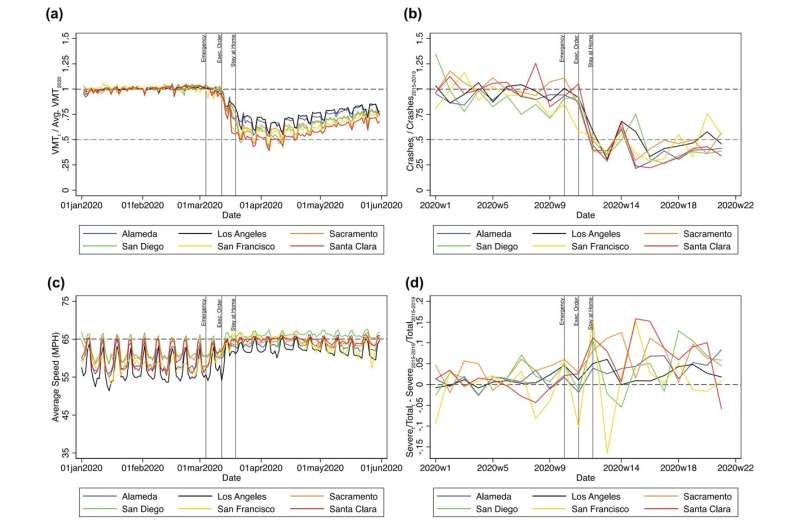This article has been reviewed according to Science X's editorial process and policies. Editors have highlighted the following attributes while ensuring the content's credibility:
fact-checked
trusted source
proofread
In the wake of COVID-19, traffic congestion dropped but crash severity soared

The initial COVID-19 restrictions in March 2020—particularly stay-at-home orders—put the brakes on driving for many Americans, resulting in fewer cars on the highways and dramatically fewer crashes. But then a curious thing happened: Average speeds began to surge in urban areas previously known for traffic congestion, resulting in a 25% increase in severe crashes, according to recent research.
The study, co-authored by Jonathan E. Hughes, an associate economics professor who specializes in transportation and energy economics, analyzed detailed crash, speed and traffic flow data across California freeways in the first 11 weeks of the COVID-19 response. Researchers found that during that period, highway driving decreased by approximately 22% and total crashes decreased by 49%.
"But there was a counteracting effect," Hughes said. "In places where there was a lot of traffic congestion prior to COVID, reducing the number of cars on the road reduced congestion and made it possible to travel much faster. Your speed was limited by the speed limit and how fast you were comfortable driving, not by the other drivers on the roadway. What that means is, if you got into a crash under those conditions, it was more likely to be a severe crash."
Using data from the California Department of Transportation and the California Highway Patrol, researchers found that average highway speeds increased by 2 to 3 mph across all counties in California, but they increased as much as 10 to 15 mph in some counties like San Francisco and Santa Clara that are well-known for congestion. The share of severe crashes increased nearly 5 percentage points, or approximately 25%, between March 12, 2020, and May 31, 2020, the period studied.
Researchers call this bump the "speed effect," and found that it is prominent in areas with high pre-existing levels of traffic congestion.
"There were fewer people driving and there were fewer crashes, but those crashes that occurred happened at much higher speeds and so fatalities increased," Hughes said. "If you add it up all over California during the first few months of the COVID period, fatalities went down. But then as a few more people started driving and speeds remained high, that speed effect began to take over, such that the overall effect was no reduction in fatalities."
The unique period in the early days of the COVID-19 response provided researchers with an opportunity to isolate and understand how government policies, congestion and speed may indirectly affect vehicle crashes and ultimately fatalities. They point to National Highway Safety Administration data that more than 6 million motor vehicle crashes occur in the U.S. each year, resulting in some 30,000 deaths.
"It's very difficult to tease apart the contributions of different factors, but during this period, it was almost like an experiment. We're going to take a whole bunch of cars off the road and see what happens. That allowed us to isolate the separate effects of speed versus just more driving on highway fatalities," Hughes said.
The study, the final version of which was published in April 2023 in Transportation Research Record, was co-authored by CU Boulder economics Professor Daniel Kaffine and independent researcher Leah Kaffine. The data didn't allow a look into the psychological and behavioral profiles of drivers during the initial COVID-19 period, but researchers were able to examine the demographics of drivers involved in crashes.
"What we found is that during COVID, drivers involved in crashes were more likely to be younger, more likely to be male—things the insurance literature has shown are predictors of a higher likelihood of accidents," Hughes said.
He added that during COVID-19, the more risk-averse people may have stayed home more.
"I think it's a little more nuanced than that, but the data doesn't allow us to explore (this possible trend) that deeply because we only observe basic demographic information on the individuals involved in crashes. Riskiness is much more difficult to measure," he said.
However, the researchers were able to look at age distributions for single-car crashes. They found an increase in fatalities across the spectrum among both younger and middle-aged drivers, which "suggests the increase in crash severity we document is not isolated to younger and potentially riskier drivers," according to the paper.
Hughes said the study's results have policy implications beyond COVID-19, as state and local policies that reduce congestion and increase highway speeds are likely to result in similar increases in crash severity.
"The big takeaway is looking at the things we do that increase driving but might also allow speeds to stay high will lead to more fatalities, and things we do to decrease driving but do not have that speed effect would tend to reduce fatalities," Hughes said.
He emphasized that whether specific policies will increase or decrease the number of fatalities on the road depends on traffic patterns in specific areas.
"The key thing is this idea that if you're someplace that's congested already, then reducing the number of cars during COVID made it possible for people to drive a lot faster, and that was bad," Hughes said. "Whereas if you're in a place that was not that congested, you just stayed home and it was a lot safer. So interpreting our results, you have to do that through the lens of what traffic conditions look like where you are."
The study is published in the Transportation Research Record: Journal of the Transportation Research Board.
More information: Jonathan E. Hughes et al, Decline in Traffic Congestion Increased Crash Severity in the Wake of COVID-19, Transportation Research Record: Journal of the Transportation Research Board (2022). DOI: 10.1177/03611981221103239
Provided by University of Colorado at Boulder




















